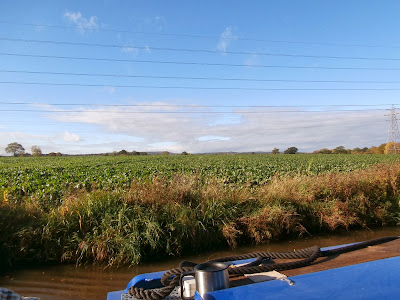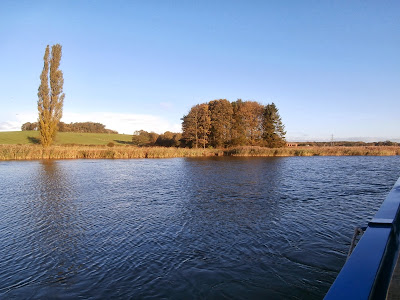We had left our mooring on the Shroppie nice and early, just before sun rise. There was plenty of ice on the roof and the ropes were stiff with frost. It was going to be a fairly long day for us, a couple of miles before the stop lock and then half a mile or so to the Wolverhampton 21. User friendly narrow locks heading up to Birmingham. We were in no hurry and by now the frost had started to melt and it was looking like good locking weather not too bright and hardly a breath of wind. The first few locks were in our favour and with light paddle we were soon into our stride.
The locks were also fairly shallow so as soon as I had steered LJ into a lock that Deb had prepared, I got up on the roof and then it was only a few feet up to the lock side so no need to walk down the length of the boat to the lock ladder. I would close the last bottom gate and Deb would unlock the security bolt on the upper paddles, and half wind up paddle before heading off to get the next lock prepared. Once LJ was at the top of the lock I would exit and shut the gate relocking the security bolt on the paddles.
After the first half a dozen locks Deb started to find the upper gates open. Now sometimes the gates aren't particularly well balanced and open again, sometimes the wind can blow them back open, and sometimes it's a lazy git who can't be bothered getting off their boats to shut the gates. As we progressed even the security bolts hadn't been reset meaning that any little oik could open the paddles and run a pound dry. The next lock we meet one of the CaRT guys who said one of the pounds was very low ahead of us and he was running down some water for us. The boater before us (previous evening) was the reason the gates were open, lazy git! The CaRT guys we kind enough to set the next couple of locks for us and even open the lower gates so I could cruise on in. It was about now that the trip entered the second half of a trip very much of two halves.
Part cloud, dry, 8°c air temperature, 4°c water temperature.
We were plodding on in our own time, we were ahead of any kind of schedule. We were aiming to be at the top of the flight by mid afternoon to collect a coal delivery from Wulfruna Coal Co but we were nearly half way through and it wasn't much after 10.00
Neither of us were very sure of what happened at lock side. Deb was walking back from the next lock up the flight and was a few hundred feet away. She said she thinks I may have slipped the windlass off the spindle and lost balance, I could have been about to walk around the paddle gear to cross the gate and slipped on the smoothed quoin stone - they are often smooth and slimey, and the towpath was still icy.
I was wearing my heavy walking boots, Mendle Borneo with Vibram soles that are OK in mud, great on lose scree, but not very good on slimey lock sides. Unfortunately the layers of clothing that had kept me warm all morning were now conspiring against me. The, close to freezing, canal water was rapidly soaking through my windproof fleece outer layer, my fleece lined farmers shirt, a fast wicking T-shirt and finally a heavy thermal top. My jeans would also soon start feeling heavy and the thermal long johns would restrict my movement.
I had reached out for the hand rail as I went over but my brain wouldn't allow me to release my grip on the windlass. The force of the collision instantly numbed my thumb that had taken the full thrust. I thought these kind of accidents were meant to happen in slow motion but in the blink of an eye I was under looking at the windlass still in my hand with a certain degree of confusion. Brain into gear, I decided that the windlass wasn't that important after all. Now that's weird, I had let go of the windlass and it was staying where it was, suspended in the murk but I was still going down.
I thought these bloody canals were meant to be shallow! I decide I had better kick for the light. I had only been submerged for a couple of seconds but knew what the process was. Being keen sea kayakers for years we both know the importance of knowing how a kayak performs in a spill and had practiced capsize drills on occasion. First part of the cold shock response is the dreaded and deadly gasp reflex. Jumping into the sea or tipping a kayak over the gasp reflex is minimised by getting your head, or at least back of your neck, wet first. If you're lucky the gasp comes before your head goes under, if you're really switched on you can stop your head going under by ensuring that when you go jump/fall in you have one leg in front and one behind and as you go in you swap them over and make that the start your leg kick. Unfortunately I was not too switched on and after scrabbling for the hand rail had gone in backwards.
Within no more than ten seconds or so I had kicked to the surface and caught hold of the quoin stone on the outside of the lock. Deb had arrived in double quick time, it was important that she didn't try to pull me out, you have to be realistic about your abilities. With all my sodden layers and boots full of water I would guess that I had added at least three stones to my already considerable mass. I knew what I needed but by now if been submerged in 5°c water for a good few minutes. I decided to duck down give a big kick off the wall under the water and pull myself out. Unfortunately there isn't a bit of wall under the quoin stones just a big cavity where the water goes from the pound into the lock to fill it up. So I slipped under again with nothing solid to kick off. My calm request for a rope to facilitate a foot loop to help climb out came out something like 'HHH...I HNEED...HA..ROPE, GHHET HA HROPE' I was rather chilly.
Deb had the foresight to leave the bow rope attached to the front of the boat that was just the other side of the lock. I asked her to make a loop thinking that something big enough to put my boot through was all that was needed. Knots aren't Debs forte. We compromised on just chucking the rope in and looping the free end around the nearby paddle gear. My muscles were starting to suffer the cold. I got a foot hold and kicked up pushing with my arms, holding that position whilst Deb pulled in the slack off the rope until I was high enough to fall onto the canal side.
At least we had plenty of hot water as the engine had been running for a few hours. My sodden clothing made two machine loads and it looked like I had walked most of the canal into the boat. Within ten minutes it was all over, mug of tea in hand and off to the next lock. I was taken off locking duties and confirmed as a 'proper boater'. If only it had been the summer. Right, time to look for a new phone and a replacement windlass.


















































